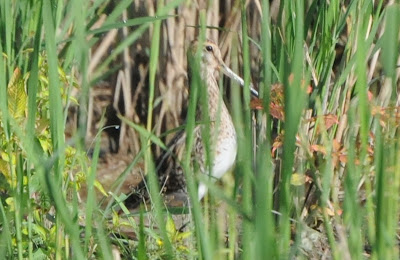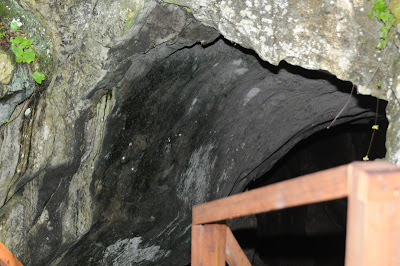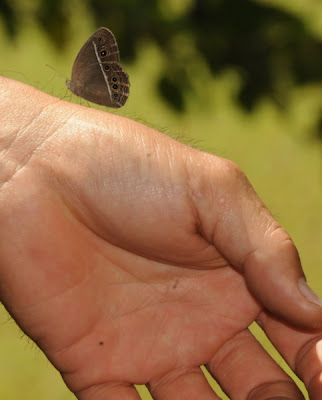The rice paddies at Chupak, a "hidden" valley about an hour's drive south of Kuching, have featured before in these postings. Here we are again (on February 21, 2012), this time in the company of my friend Vincent Wong.
Chupak is a highly attractive area, and the birds are easily accessible from the dikes that run between the paddies.
Things are changing here, though. Small combine harvesters have been brought in as part of a pilot project to modernize rice production - with what ecological consequences, it is probably too early to say.
Cinnamon Bitterns (Ixobrychus cinnamomeus) are a fairly common sight, usually flying, but now and then posing watchfully within camera range.
Wood Sandpipers (Tringa glareola) are probably the commonest wintering shorebird in the rice fields.
Snipe are reasonably common, too, and fairly easy to see. Putting a name to them, though, is another matter. The two likely species, Swinhoe's Snipe (Gallinago megala) and Pintail Snipe (G. stenura), are almost impossible to distinguish in the field, and the subtle differences in face pattern among the birds in these photos do not seem to be guides to which species they are.
.JPG)
Without access to something like Vincent's howitzer of a telephoto lens (fitting something like that in hand luggage can get you in trouble at the airline counter!), I find I can better results photographing nearby insects than attempting to get good images of distant birds. Fortunately, Chupak is good for that, too. Giant Carpenter Bees (Xylocopa latipes), for example, make gratifying subjects.
The Great Eggfly (Hypolimnas bolina) is a butterfly with a huge range, from Madagascar in the west to Japan and Polynesia in the east. it is also known as the Common Eggfly, demonstrating, I suppose, that it is possible to be both great and common at the same time.
Females come in a variety of morphs, each mimicking another butterfly. They are also unusual in that they exhibit parental care, guarding the leaves where they have laid their eggs. This one, though, appears to be a male.
The Blue Pansy (Junonia orithya) is a common and attractive butterfly of open country.
I'm pretty hopeless at Skipper identification, but I believe that this may be a Contiguous Swift (Polytremis lubricans).
As you might expect, Chupak is an excellent place to photograph dragonflies, including the abundant (indeed, inescapable) Orthetrum sabina.
Here is a mating pair "in wheel".
Here is another pair "in wheel", this time of a related species, Orthetrum testaceum.
From the paddies Vincent and I moved on to inspect the entrance to the local cave system. The limestone hill country south of Kuching is riddled with caves, including some that are heavily promoted as tourist attractions. This one, apparently under the jurisdiction of the local tourism committee, is far less well-known.
Chupak can get extremely hot as the day progresses, but a blast of cool, moist air from the cave mouth is not only refreshing but has created a miniature local ecosystem.
This is one of those places where I could really use a good botanist! I assume that this is an aroid of some sort?
Any ideas, anyone? Anyway, I thought this was an attractive natural composition.
This plant, with its long, hanging, strap-like leaves, appears to be a fern, but I don't know which one.
This is not normally the sort of photograph that I would show anyone, but the animal disappearing into the bushes at the cave mouth is an interesting one: a Lesser (or Pygmy) Treeshrew (Tupaia minor). Treeshrews are often mistaken for squirrels, and most of them are similarly acted by day, but they actually represent a separate and distinctive mammal order, the Scandentia, confined to Southeast Asia and related to our own order, the Primates (in which they were once included).
The cave mouth was popular with butterflies, including another Great Eggfly (this time, I believe, a female).
We found this Baron (Euthalia aconthea) on the guard rail to the cave entrance, presumably picking up salt from the sweaty hands of previous visitors.
Here is a Dusky Sailor (Neptis omeroda), one of the more distinctive of a large complex of similar-looking, mostly black-and-white nymphalid butterflies.
Sweat, this time taken directly from Vincent's wrist, is an attraction for this bush brown (a species of Mycalesis, though I am not sure which one).
This highly attractive butterfly is a Commander (Moduza procris). Commanders are partial to perching open-winged on stones, as this one is doing. As beautiful as it is, it starts life as a particularly grotesque caterpillar with the odd habit of walling itself off behind a palisade of toxic droppings. Anyway, it was a new butterfly for me.











.JPG)














.JPG)







We snuck around the gate today and checked the place out. Didn't go into the cave, as the entire park seems to have fallen off the maintenance grid years ago. The ticketing house is falling apart, the path around the lake is badly overgrown...what gives? We did see a bunch of nice stic insects, though, and the cool air from the cave was just as you described!
ReplyDelete